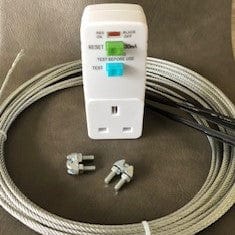PIR Sensors
What Are PIR Sensors?
What Does PIR Stand For?
PIR stands for Passive Infrared. We commonly use the term PIR in the context of a PIR sensor, which detects movement to initiate an electronic device.
When do we use PIR?
In lighting, you find PIR sensors on certain outdoor wall lights, security lights and camera lights to activate the light or camera when movement is detected. Used above front doors, porches, gardens and driveways, PIR lights help to improve visibility when you go outside at night. In addition, they act as a deterrent to intruders. They also improve power consumption. They save power because the light or camera is only activated when required rather than being left running.
How Does a PIR Sensor Work?
A PIR sensor can detect infrared energy from an object. This infrared energy is detectable in the form of light generated by the heat of an object. So, for example, people and animals can be detected, as also other things that create heat, such as cars, motorbikes, etc. If an object enters within the detection range or field of view of a PIR sensor, it will trigger the action.
What is the Difference Between a PIR Sensor & a Motion Sensor?
A motion sensor is triggered based on a percentage of pixel change within its field of view. This percentage can vary depending on the sensitivity of the sensor. A motion sensor is similar to a PIR sensor because it will trigger an action when objects enter its field of view, but it uses size as a measure instead of infrared energy.
What is the Difference between a PIR Sensor and a Dusk To Dawn Sensor?
A Dusk To Dawn sensor detects the level of brightness of an area, and if the brightness reaches a predetermined level, it will initiate an action. For example, Dusk To Dawn sensors are used on certain outdoor lights to switch the light on once the day becomes dusk. Then, as morning comes and brightness increases, the Dusk Until Dawn sensor will switch the light off. So while a PIR sensor activates the light based on detected movement, a Dusk Until Dawn sensor activates the light based on the detected brightness of the environment. The level of brightness that activates the Dusk Until Dawn sensor is known as the lux.
How to Adjust PIR Lights
PIR lights are often available with a range of different adjustable settings. For example, on many types of PIR sensors, settings like the detection range, lux, the length of time that the light remains on after being triggered, the brightness of the light, and the physical direction of the sensor can all be adjusted. The typical settings of PIR lights can include:
Detection Range - fixed or adjustable distance that the sensor will detect motion.
Lux - fixed or adjustable level of environmental brightness to differentiate between night and day.
Time Setting - fixed or adjustable amount of time a light stays switched on after being triggered.
Adjustable sensor - fixed, able to turn, or tilt & turn.
Ambient light - a soft light that stays on but switches to a powerful beam when triggered.
Double Sensors - motion detection in front of the light and also underneath the fixture and against walls.
Test Mode - test your PIR sensor for the best detection area.
PIR Override - have lighting switched on without it being triggered.
If you are interested in the various features and functions of our range of PIR lights, please refer to each product page's specifications section. There, you will find the information listed to determine the best light for your outdoor space. Please contact our expert sales team online or by phone for further information or clarification.









